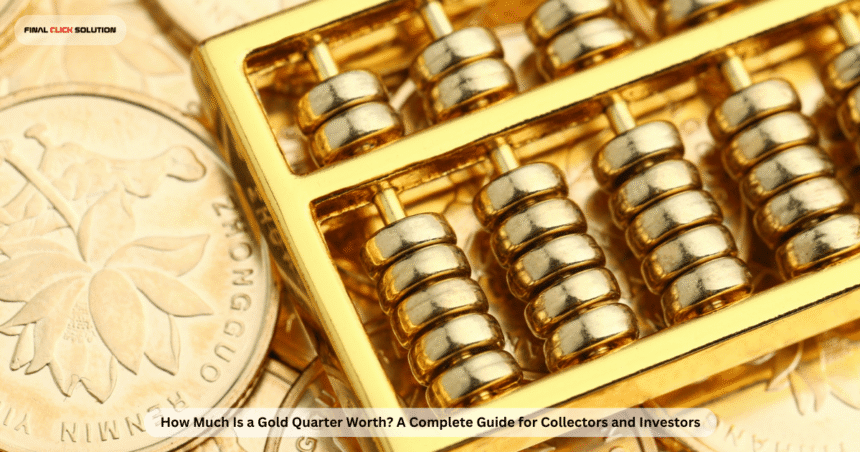Introduction
If you’ve ever come across a shiny gold-colored quarter or heard someone talk about a “gold quarter,” you might have wondered: how much is a gold quarter worth?
At first glance, it might look like an ordinary U.S. quarter dipped in gold — but not all gold quarters are created equal. Some have genuine gold value, while others are simply plated for appearance.
This guide dives deep into the details — from what defines a gold quarter, how to determine its real value, and how market prices for gold affect its worth. Whether you’re a collector, investor, or just curious, by the end of this article you’ll know exactly what makes a gold quarter valuable (and what doesn’t).
What Is a Gold Quarter?
A gold quarter generally refers to one of two types:
- Gold-Plated Quarters (Novelty Coins):
These are standard U.S. quarters (usually Washington or State Quarters) that have been plated with a thin layer of gold — typically 24-karat — for decorative or commemorative purposes. - Genuine Gold Quarters (Minted in Gold):
These are actual coins made of gold, often issued by private mints or special U.S. Mint releases (though rare). Their value is based on their gold content and collectible rarity.
Understanding which category your coin falls into is the first step in answering the question: how much is a gold quarter worth?
1. Gold-Plated Quarters: Appearance Over Value
What Are They?
Gold-plated quarters are usually standard circulation coins (like the 1999 Delaware State Quarter) that have been coated with a thin layer of gold. Companies often sold these as “limited edition collectibles” during the State Quarters Program from 1999–2008.
Gold Content
The gold plating is extremely thin — typically less than 0.003 inches. This means the total gold weight is less than $1 worth of gold, even at today’s market prices.
Monetary Value
- Face Value: $0.25
- Gold Value: Negligible (less than $1)
- Collector Value: $1–$5 (depending on condition or presentation)
Key Takeaway
If your gold quarter came from a commemorative set or looks plated rather than solid, it’s not made of real gold. Its value is primarily sentimental or aesthetic, not monetary.
2. Genuine Gold Quarters: When Gold Content Matters
What Are Genuine Gold Quarters?
These are legal tender coins actually made of gold, not plated with it. However, the U.S. Mint does not produce circulating gold quarters. Instead, certain special edition or privately minted gold coins are created in the size or design of a U.S. quarter but struck in real gold.
Examples include:
- Commemorative gold quarters by private mints
- Fractional gold coins (¼-ounce or ¼-dollar replicas)
- Custom bullion coins inspired by U.S. designs
Gold Content and Purity
The value of a real gold quarter depends mainly on:
- Gold weight (often ¼ ounce or less)
- Gold purity (commonly .999 fine gold)
- Current gold market price
For instance, if your coin contains ¼ ounce of 24-karat gold, its intrinsic value is determined by the current gold spot price.
3. Understanding Gold Prices and Their Impact
The Gold Spot Price
The spot price of gold changes daily based on market supply and demand. It’s measured per troy ounce (1 troy ounce = 31.1 grams).
Let’s say today’s gold spot price is $2,400 per ounce.
To calculate how much a coin’s gold is worth:
- A ¼-ounce gold coin = 0.25 × $2,400 = $600 worth of gold.
So, if your coin is made of ¼ ounce of pure gold, that’s your base metal value — even before factoring in collector premiums or rarity.
4. Factors That Determine a Gold Quarter’s Value
To truly know how much is a gold quarter worth, several factors must be considered:
1. Gold Content
The actual gold weight and purity (e.g., 22k vs 24k) are the biggest value drivers.
2. Rarity
Limited-edition mintages, misprints, or historic releases often command higher premiums.
3. Condition (Grading)
Coins in mint or proof condition hold higher collectible value than those with scratches or wear.
4. Market Demand
If collectors actively seek a particular edition (such as early State Quarters plated in gold), prices can temporarily rise.
5. Authenticity
Genuine gold coins from recognized mints (e.g., U.S. Mint, Royal Canadian Mint) are worth far more than unverified novelty items.
5. How to Identify if Your Gold Quarter Is Real
Determining authenticity is essential. Here’s how you can test it:
1. Check the Weight
A regular U.S. quarter weighs 5.67 grams.
If your coin weighs significantly more, it may contain real gold.
2. Magnet Test
Gold is non-magnetic. If your coin sticks to a magnet, it’s not gold.
3. Edge Examination
Gold-plated coins often show silver edges where the plating has worn off.
4. Professional Appraisal
Visit a certified coin dealer or use professional grading services like:
- NGC (Numismatic Guaranty Company)
- PCGS (Professional Coin Grading Service)
They can verify authenticity and provide a precise valuation.
6. Examples of Valuable Gold Quarter Variants
Here are some examples of quarters that may hold real value:
1. U.S. Mint Commemorative Issues
Occasionally, the Mint releases gold versions of historic coins for anniversaries — such as the 2016 100th Anniversary Gold Standing Liberty Quarter.
- Composition: 0.25 oz of 24-karat gold
- Original Price: Around $450
- Current Market Value: Approximately $600–$700 (depending on gold price and demand)
2. Private Mint Bullion Coins
Private mints sometimes create gold replicas of classic designs (like the Washington Quarter) for investors.
- Composition: ¼ oz fine gold
- Value: Equal to or slightly above current gold market value.
3. Error Coins
Rare minting errors, such as double-die or misprints, can fetch high collector premiums.
7. Common Misconceptions About Gold Quarters
Many people confuse gold-plated quarters with solid gold coins. Let’s clarify some common myths:
| Myth | Reality |
|---|---|
| “All gold-colored quarters are made of gold.” | Most are plated and have minimal gold value. |
| “The U.S. Mint makes circulating gold quarters.” | False — no gold quarters circulate as legal tender. |
| “A gold quarter is automatically worth hundreds.” | Only if it contains real gold or is a rare collectible. |
| “Plated coins from TV ads are investments.” | Usually not — they’re decorative items with little resale value. |
8. Where to Sell or Appraise a Gold Quarter
If you believe your gold quarter is valuable, here’s where to verify or sell it:
1. Coin Dealers
Professional numismatists can appraise and buy collectible coins at fair market prices.
2. Precious Metal Buyers
If your coin is solid gold, bullion dealers will buy it based on its gold weight.
3. Online Marketplaces
Platforms like eBay, Heritage Auctions, or APMEX allow you to list collectible gold quarters, but ensure proper authentication first.
4. Gold Refiners
If the coin is damaged or purely for melt value, refiners can pay based on gold content.
9. Investment vs. Collectible Value
When assessing how much is a gold quarter worth, it helps to decide whether you view it as an investment or a collectible.
- Investment Value: Based purely on gold weight and market prices.
- Collectible Value: Driven by rarity, design, and historical significance.
Genuine 24k gold quarters, such as the Standing Liberty Centennial release, hold both types of value — they’re tangible gold investments and limited collectibles.
10. Current Gold Price Trends and What They Mean
As of late 2025, gold prices have remained strong, often hovering between $2,300–$2,500 per ounce due to global inflation and market volatility.
This directly affects how much genuine gold coins are worth — including gold quarters.
If gold prices rise, so does the melt value of genuine gold quarters. However, plated quarters will remain mostly unchanged in price since their gold layer is too thin to matter.
11. Comparing Gold Quarters with Other Gold Coins
| Coin Type | Gold Weight | Average Market Value | Purpose |
|---|---|---|---|
| 1 oz Gold American Eagle | 1 oz | $2,400+ | Investment |
| ½ oz Gold Coin | 0.5 oz | $1,200+ | Investment |
| ¼ oz Gold Quarter Replica | 0.25 oz | ~$600 | Collectible/Investment |
| Gold-Plated State Quarter | <0.001 oz | <$5 | Decorative |
This table shows why understanding composition is critical when determining a gold quarter’s worth.
12. FAQs About Gold Quarters
Q1: Are gold quarters real money?
Yes, if it’s a U.S. Mint commemorative issue, it has a legal tender value, but its gold content far exceeds face value.
Q2: Can I spend a gold quarter like a regular quarter?
Technically yes, but you’d lose hundreds of dollars — the gold value is much higher.
Q3: How can I find current gold prices?
Check financial websites like Kitco, GoldPrice.org, or MarketWatch for live gold spot prices.
Q4: How much is a golden quarter worth?
The term “golden quarter” often refers to gold-plated coins. Their value is typically under $5, unless they are genuine gold issues or rare collector pieces.
Conclusion
So, how much is a gold quarter worth?
It depends entirely on what you have in hand.
If your coin is gold-plated, it’s primarily a novelty item worth its face value plus minor collector interest. But if it’s a real gold coin—especially one minted in ¼ ounce of 24k gold—its value will closely follow the current gold price, which can be around $600 or more.
Always verify authenticity, gold content, and condition before buying or selling. For investors, genuine gold quarters offer a beautiful and compact way to own physical gold. For collectors, they’re a fascinating blend of art, history, and precious metal value.
Whether you own one or plan to buy one, knowing the true worth of a gold quarter ensures you make informed and valuable decisions in your journey as a coin enthusiast or gold investor.








